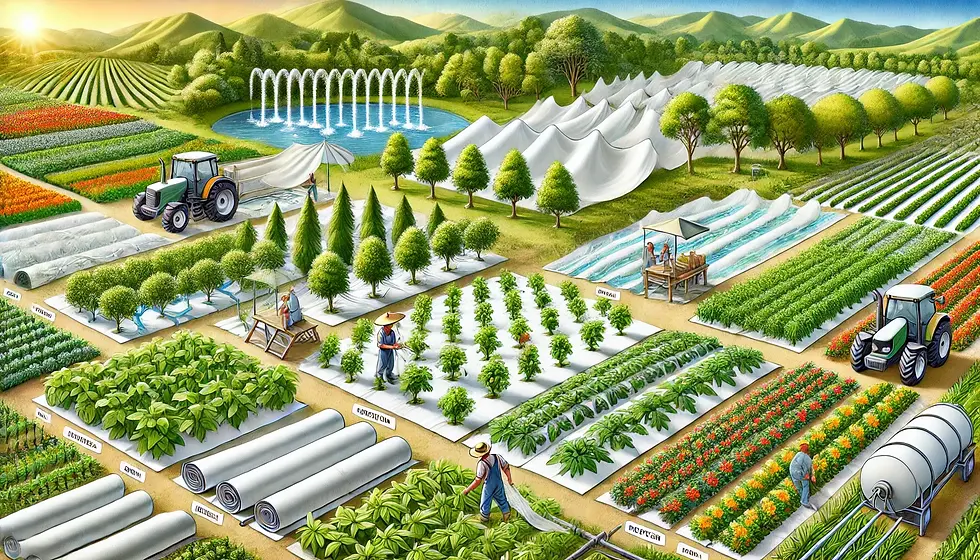Nonwovens in Agriculture and Horticulture: Revolutionizing Crop Production
- RShanker DiTan
- Nov 13, 2024
- 3 min read
Thanks to creative application of nonwoven fabrics, the fields of horticulture and agriculture have changed during the past few years. Originally mostly connected to industrial and medical uses, these materials have since become a mainstay for effective and environmentally friendly farming. Nonwovens have special qualities that provide farmers and horticulturists flexible options that advance crop health, lower costs, and increase yield.

Knowing Nonwoven Materials
Nonwovens, unlike conventional woven goods, are produced by entangling or glueing fibres together without weaving. Lightweight, permeable, and customisable fabrics produced with this technique can be fitted to particular agricultural use. Common materials with known durability and environmental resistance are polypropylene and polyester.
Nonwovens' advantages for agricultural
Crop protection
Nonwoven crop covers insulate crops from sudden frosts, strong winds, and significant temperature swings, therefore safeguarding young plants and extending the growing season.
Nonwoven fabrics help to control pests and diseases by serving as a barrier, therefore lowering the need for chemical treatments and improving crop quality.
Many nonwovens are processed to give UV protection, therefore reducing plant stress and enhancing general crop development.
Agricultural Management of Weeds
For many farmers, weed control presents a significant obstacle. By blocking sunlight and still allowing air and moisture to pass through, nonwoven mulching materials discourage weed development and thus support good plant growth free from the need for chemical herbicides.
Water Resources Conservation
Nonwovens help to maximise water retention and lower evaporation, therefore preserving soil moisture levels and saving water. In areas suffering drought or water shortage, this is particularly important.
Effective seed starting
Made from nonwoven materials, seed blankets produce a regulated germination habitat. These blankets provide constant warmth and humidity, which increases germination rates and stimulates more robust plant growth.
Nonwovens: Uses in Agriculture and Horticulture
Row Covers and Crop Coverings
Lightweight nonwoven row coverings shield crops without limiting air or light passage. Faster development is encouraged by this; it also offers a barrier against insects and helps to preserve ideal microclimates for plants.
Sheet Mulching
Laid over ground surfaces, nonwoven mulching sheets help to reduce weed growth, slow down soil erosion, and improve soil temperature control. Naturally breaking down over time, they are biodegradable and environmentally beneficial.
Roots Bags
Popular in nurseries and for tree growing, nonwoven root sacks By facilitating air pruning and hence lowering transplant shock when transferring plants, these bags help to encourage good root development.
Covering greenhouses
Greenhouse covers made of nonwovens give the perfect growing conditions. They guard against damaging weather elements, help control humidity, and lower heat loss from crops.
Control of Irrigation Textures
Systems of drip irrigation use nonwovens to evenly distribute water and stop soil erosion. Their water-retention qualities additionally guarantee more efficient water reaching of plant roots.
Environment and Sustainability: Impact
Nonwoven agricultural application fits with environmentally friendly farming methods. Eco-friendly and biodegradable nonwovens serve to cut plastic waste and lessen the effects of agricultural production on the surroundings. Their capacity to lower the necessity for chemical treatments also helps to minimise pollution of soil and water.
Nonwovens: Their Future in Agriculture
The nonwoven sector keeps innovating and presents fresh, better goods for horticulture and agriculture. As demand for effective and environmentally friendly farming methods rises, nonwovens' importance should also rise. Intelligent nonwovens with sensors to track soil and crop conditions, smart mulches with adjustable water retention capacity, and biodegradable goods completely merging with the surroundings could all be part of future developments.
Finally,
Nonwovens have transformed agriculture and horticulture from frost protection and weed control to enhancing crop health and water conservation. For farmers and horticulturists all around, their adaptability, sustainability, and capacity to handle a broad spectrum of problems make them priceless instruments. Nonwoven materials will be increasingly important in the future of agriculture as innovation develops, therefore promoting a more sustainable, efficient, and productive farming scene.


Comments